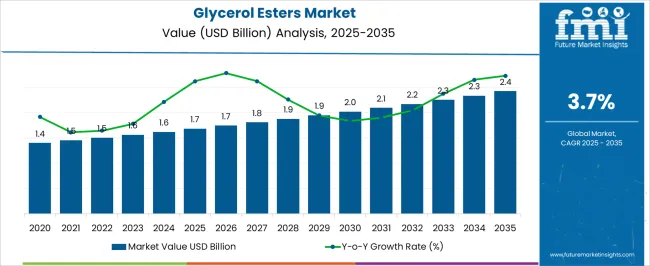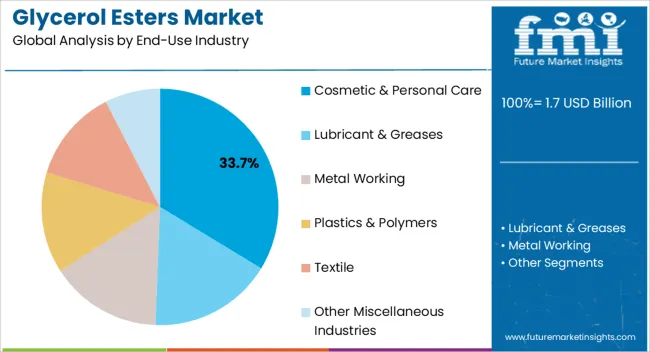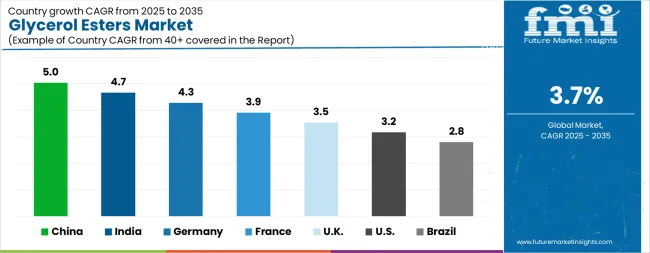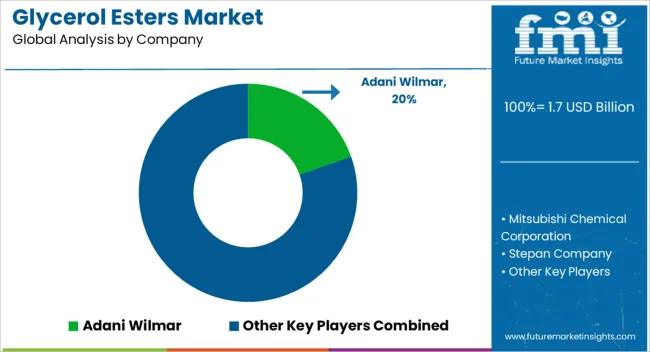The Glycerol Esters Market is estimated to be valued at USD 1.7 billion in 2025 and is projected to reach USD 2.4 billion by 2035, registering a compound annual growth rate (CAGR) of 3.7% over the forecast period.

| Metric | Value |
|---|---|
| Glycerol Esters Market Estimated Value in (2025 E) | USD 1.7 billion |
| Glycerol Esters Market Forecast Value in (2035 F) | USD 2.4 billion |
| Forecast CAGR (2025 to 2035) | 3.7% |
The Glycerol Esters market is experiencing steady growth, driven by the increasing demand for multifunctional additives across food, cosmetic, pharmaceutical, and personal care sectors. Rising consumer preference for products that offer enhanced texture, stability, and emulsification properties has accelerated adoption of glycerol esters. These esters are used to improve the quality, consistency, and shelf life of formulations, supporting manufacturers in meeting evolving consumer expectations.
Regulatory frameworks emphasizing safety, biodegradability, and non-toxicity further encourage the use of glycerol esters in diverse applications. Continuous research and development efforts are enhancing the functional properties of these esters, enabling broader application across high-value products. Increasing awareness about sustainable ingredients and clean-label formulations is also driving demand in cosmetics, personal care, and food sectors.
As manufacturers prioritize product innovation and formulation efficiency, glycerol esters are being increasingly integrated to meet both performance and regulatory requirements The market is expected to sustain long-term growth, supported by ongoing advancements in processing technologies and rising consumer demand for high-quality, multifunctional products.
The glycerol esters market is segmented by end-use industry, and geographic regions. By end-use industry, glycerol esters market is divided into Cosmetic & Personal Care, Lubricant & Greases, Metal Working, Plastics & Polymers, Textile, and Other Miscellaneous Industries. Regionally, the glycerol esters industry is classified into North America, Latin America, Western Europe, Eastern Europe, Balkan & Baltic Countries, Russia & Belarus, Central Asia, East Asia, South Asia & Pacific, and the Middle East & Africa.

The cosmetic and personal care segment is projected to hold 33.7% of the Glycerol Esters market revenue in 2025, establishing it as the leading end-use industry. Growth in this segment is driven by the increasing demand for skin care, hair care, and personal hygiene products that require superior texture, stability, and emulsification. Glycerol esters are used extensively as emulsifiers, moisturizers, and stabilizing agents, enabling formulations to maintain consistent performance and quality over time.
Rising consumer preference for clean-label, sustainable, and multifunctional ingredients has reinforced adoption in this industry. The ability of glycerol esters to enhance sensory attributes while improving product stability provides significant advantages for manufacturers. Increasing investments in cosmetic and personal care research, product innovation, and premium offerings are further supporting market growth.
Regulatory emphasis on safe and non-toxic ingredients ensures that glycerol esters continue to be preferred in formulations As the cosmetic and personal care industry expands globally and consumer expectations for high-quality products rise, this segment is expected to maintain its leading market position, supported by innovation and versatile functionality.
The chemical compounds derived from an acid, which contains at least an alkyl group (–O) replacing the hydroxyl group (–OH) are known as esters. Glycerol esters are one of the prominent classes of lipids. Glycerol esters, also known as glycerides, or acylglycerols have three hydroxyl groups.
These functional hydroxyl groups can be esterified with either one, two, or three fatty acid groups in order to form monoglycerides, diglycerides, and triglycerides respectively. Glycerol esters of fatty acids are esters of fatty acids and glycerol and their derivatives. These are, usually, colourless to brown powders, waxy solids or liquids and are composed of fatty acid chains which offer a lipophilic part and ester functional group which yields a hydrophilic end.
Some of the glycerol esters of fatty acids include glycerol acetic acid fatty acid ester, glycerol lactic acid fatty acid ester and glycerol succinic acid fatty acid ester, among the others.
Triglycerides are mostly present in animal fats and vegetable oils that can be broken down by lipases into its mono and diglycerides form. Reaction between the glycerides and sodium hydroxide results in the formation of soaps which contain fatty acids that emulsify the oils in dirt in turn enable the removal of dirt. Glycerol esters commonly find application as surfactants which act as emulsifiers, especially in personal care and cosmetics industry.

| Country | CAGR |
|---|---|
| China | 5.0% |
| India | 4.7% |
| Germany | 4.3% |
| France | 3.9% |
| UK | 3.5% |
| USA | 3.2% |
| Brazil | 2.8% |
The Glycerol Esters Market is expected to register a CAGR of 3.7% during the forecast period, exhibiting varied country level momentum. China leads with the highest CAGR of 5.0%, followed by India at 4.7%. Developed markets such as Germany, France, and the UK continue to expand steadily, while the USA is likely to grow at consistent rates. Brazil posts the lowest CAGR at 2.8%, yet still underscores a broadly positive trajectory for the global Glycerol Esters Market. In 2024, Germany held a dominant revenue in the Western Europe market and is expected to grow with a CAGR of 4.3%. The USA Glycerol Esters Market is estimated to be valued at USD 616.7 million in 2025 and is anticipated to reach a valuation of USD 842.6 million by 2035. Sales are projected to rise at a CAGR of 3.2% over the forecast period between 2025 and 2035. While Japan and South Korea markets are estimated to be valued at USD 80.7 million and USD 51.1 million respectively in 2025.

| Item | Value |
|---|---|
| Quantitative Units | USD 1.7 Billion |
| End-Use Industry | Cosmetic & Personal Care, Lubricant & Greases, Metal Working, Plastics & Polymers, Textile, and Other Miscellaneous Industries |
| Regions Covered | North America, Europe, Asia-Pacific, Latin America, Middle East & Africa |
| Country Covered | United States, Canada, Germany, France, United Kingdom, China, Japan, India, Brazil, South Africa |
| Key Companies Profiled | Adani Wilmar, Mitsubishi Chemical Corporation, Stepan Company, Evonik Industries, Emery Oleochemicals, KLK Oleo, Guangdong Guanghua BioChem Technology, Kao Corporation, Innospec, Croda International, Cargill, Wilmar International, Dow, Vantage Specialty Chemicals, and Godrej Consumer Products |
The global glycerol esters market is estimated to be valued at USD 1.7 billion in 2025.
The market size for the glycerol esters market is projected to reach USD 2.4 billion by 2035.
The glycerol esters market is expected to grow at a 3.7% CAGR between 2025 and 2035.
The key product types in glycerol esters market are cosmetic & personal care, lubricant & greases, metal working, plastics & polymers, textile and other miscellaneous industries.
In terms of , segment to command 0.0% share in the glycerol esters market in 2025.






Our Research Products

The "Full Research Suite" delivers actionable market intel, deep dives on markets or technologies, so clients act faster, cut risk, and unlock growth.

The Leaderboard benchmarks and ranks top vendors, classifying them as Established Leaders, Leading Challengers, or Disruptors & Challengers.

Locates where complements amplify value and substitutes erode it, forecasting net impact by horizon

We deliver granular, decision-grade intel: market sizing, 5-year forecasts, pricing, adoption, usage, revenue, and operational KPIs—plus competitor tracking, regulation, and value chains—across 60 countries broadly.

Spot the shifts before they hit your P&L. We track inflection points, adoption curves, pricing moves, and ecosystem plays to show where demand is heading, why it is changing, and what to do next across high-growth markets and disruptive tech

Real-time reads of user behavior. We track shifting priorities, perceptions of today’s and next-gen services, and provider experience, then pace how fast tech moves from trial to adoption, blending buyer, consumer, and channel inputs with social signals (#WhySwitch, #UX).

Partner with our analyst team to build a custom report designed around your business priorities. From analysing market trends to assessing competitors or crafting bespoke datasets, we tailor insights to your needs.
Supplier Intelligence
Discovery & Profiling
Capacity & Footprint
Performance & Risk
Compliance & Governance
Commercial Readiness
Who Supplies Whom
Scorecards & Shortlists
Playbooks & Docs
Category Intelligence
Definition & Scope
Demand & Use Cases
Cost Drivers
Market Structure
Supply Chain Map
Trade & Policy
Operating Norms
Deliverables
Buyer Intelligence
Account Basics
Spend & Scope
Procurement Model
Vendor Requirements
Terms & Policies
Entry Strategy
Pain Points & Triggers
Outputs
Pricing Analysis
Benchmarks
Trends
Should-Cost
Indexation
Landed Cost
Commercial Terms
Deliverables
Brand Analysis
Positioning & Value Prop
Share & Presence
Customer Evidence
Go-to-Market
Digital & Reputation
Compliance & Trust
KPIs & Gaps
Outputs
Full Research Suite comprises of:
Market outlook & trends analysis
Interviews & case studies
Strategic recommendations
Vendor profiles & capabilities analysis
5-year forecasts
8 regions and 60+ country-level data splits
Market segment data splits
12 months of continuous data updates
DELIVERED AS:
PDF EXCEL ONLINE
Glycerol Esters Of Wood Rosins Market
Polyglycerol Esters Of Fatty Acids Market
Esters Market Trends & Outlook 2025 to 2035
Glycerol Monostearate Market
Glycerol Extracts Market
Glycerol Diacetate Market
Polyglycerol Sebacate Market Size and Share Forecast Outlook 2025 to 2035
Polyglycerol Polyricinoleate Market Analysis - Demand, Trends & Forecast 2025 to 2035
Thioesters Market Growth & Trends 2025 to 2035
Pump Testers Market Size and Share Forecast Outlook 2025 to 2035
Fatty Esters Market Growth - Trends & Forecast 2025 to 2035
Cetyl Esters Market
Evaluating Oleate Esters Market Share & Provider Insights
Torque Testers Market
Tensile Testers Market Size and Share Forecast Outlook 2025 to 2035
Sorbitan Esters Market Size and Share Forecast Outlook 2025 to 2035
Humidity Testers Market Size and Share Forecast Outlook 2025 to 2035
Cellulose Esters Market Size and Share Forecast Outlook 2025 to 2035
Concrete Testers Market Growth – Trends & Forecast 2025-2035
Phosphate Esters Market

Thank you!
You will receive an email from our Business Development Manager. Please be sure to check your SPAM/JUNK folder too.
Chat With
MaRIA